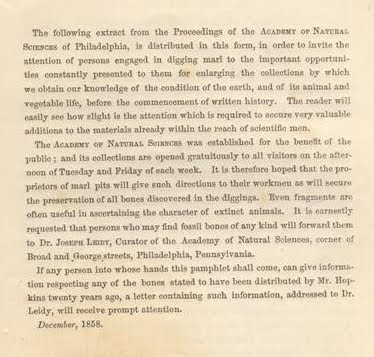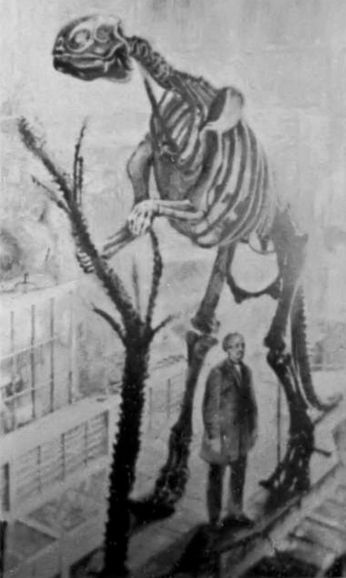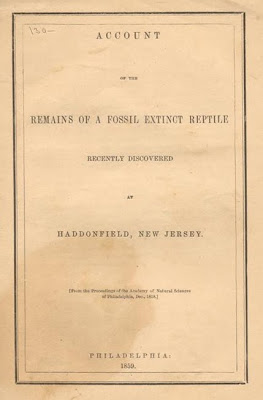I like dinosaurs. I always have. I grew up in Stamford, CT and therefore was ideally placed to enjoy the dinosaurs at the Peabody Museum at Yale (click here to see some old-school Peabody postcards from the Marianne Moore collection) and the American Museum of Natural History in NYC. I guess I was destined for a museum career from an early age, since at the age of 5 I would apparently stand up in front of the triceratops and talk about it to anyone standing around.
So imagine my delight when I found this in our collection:
The “remains of a fossil extinct reptile” mentioned on the cover are those of the famous Hadrosaurus Foulkii, which was the first substantial dinosaur skeleton (i.e. more than just a couple of teeth) found in North America. They were dug out a marl pit in Haddonfield, New Jersey, which happens to be only a ten minute walk from my current house. Here’s what the site looks like today–it was first spruced up as an Eagle Scout project in the early eighties and is now a National Historic Landmark:
 |
| Photograph by Owl’s Flight. Available under Creative Commons 2.0 license |
What the picture doesn’t show you is the bench of dinosaur toys left by visitors, which is the real reason for visiting the site, as my 5 year old and 3 year old will attest.
Anyway, back to our pamphlet. The fossils were found on the land of Mr. John Estaugh Hopkins, who had dug up a few bones in 1838 and put them in his home as curios. Twenty years later, in 1858, William Parker Foulk, a Philadelphia lawyer and fossil hunter, saw the bones and asked for permission to dig for more. He enlisted the help of his friend Dr. Joseph Leidy, at the Academy of Natural Sciences, to research and make sense of the fossils, and it was Leidy who named the species. The Rosenbach pamphlet is a reprint of a portion of the Proceedings of the Academy for 1858, which describes the discovery, provides a detailed description of the bones that were found,etc. This extract was apparently prepared in pamphlet form so it could be distributed to people who might be digging marl, as a way of alerting them to the potential for scientifically important discoveries and to enlist their cooperation in securing and preserving anything that might turn up. They also hoped they might be able to locate some of the bones from the original 1838 find.
 The Hadrosaurus would go on to become the first mounted dinosaur skeleton in the world (see below) and is now the official state dinosaur of New Jersey.
The Hadrosaurus would go on to become the first mounted dinosaur skeleton in the world (see below) and is now the official state dinosaur of New Jersey.

To find out more, the Academy of Natural Sciences did a great exhibit about the Hadrosaurus last year and you can still access information on its website. I’m just excited that the Rosenbach has a connection to this little piece of dino-history.

